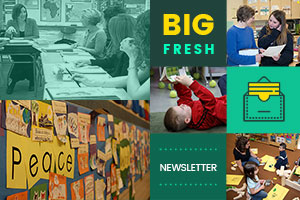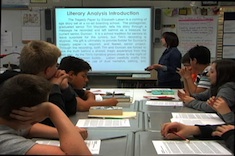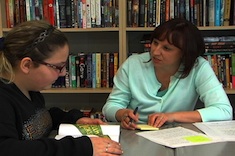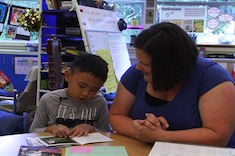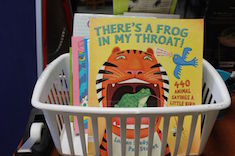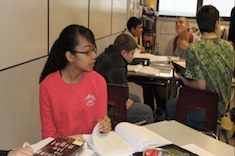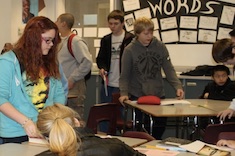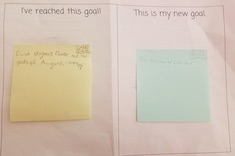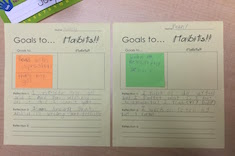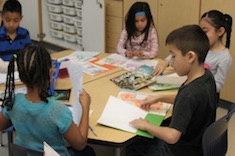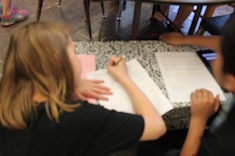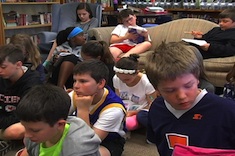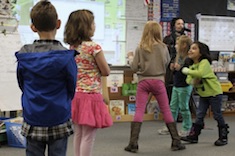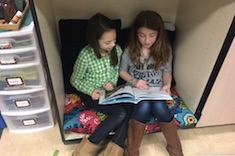Library
Choice Literacy Articles & Videos
The Choice Literacy library contains over 3,000 articles and 900 videos from 150+ contributors. Classic Classroom and Literacy Leadership subscribers have access to the entire library. Content is updated continuously, with five to six new features published each week.
Latest Content
Writing Workshop Bingo
Carly Ulmer develops a bingo board to use with her middle school students to give them more choice and foster independence while crafting writing in specific genres.
Bulletin Board of Independence
Melanie Meehan uses independence bulletin boards to provide students with options when working on their own during units of study.
The Big Fresh February 10, 2018 Again and Again
We consider how to improve lessons in this week’s Big Fresh.
One Text, Many Lessons
Tara Barnett and Kate Mills share how one book can serve as an anchor for lessons on everything from writer’s craft to test-taking skills.
Keeping Minilessons Short
Melanie Meehan gives three quick management tips for tackling the challenge many teachers face — keeping minilessons short.
The Importance of Context Minilesson
Christy Rush-Levine uses a vivid anecdote from her youth to teach her middle school students about the importance of context in literary analysis.
The Big Fresh February 3, 2018 When Your Car Is Your Teacher
We look at slowing down and paying close attention in this week’s Big Fresh.
Close Attention and Reading Response: Conferring with Tori
Christy Rush-Levine confers with eighth grader Tori about her reading response to Why We Broke Up. She encourages Tori to make connections between the characters in her current book and her previous reading by paying close attention to surprising action.
The Big Fresh January 27, 2018 Rosie’s Bucket List
We look at rereading and retelling in this week’s Big Fresh.
Revising Thinking Through Multiple Readings
We’ve all had that student — the one who blurts out a misreading of a text, only to have classmates agree with the analysis. Christy Rush-Levine explains how she uses “first-, second-, and third-draft readings” to help her middle school students develop stronger comprehension skills.
Fostering More Rereading in Classrooms
Stella Villalba explains why rereading is especially useful for young English language learners, and shares some simple strategies for integrating more rereading strategies into reading and writing workshops
Questions for Rereaders
Lifelong readers often have books they love to reread, sometimes more than once. But young readers can also get into ruts. Jennifer Schwanke explores when rereading is fine for students, and when it should be challenged. She includes a series of questions for teachers to use when conferring with children who are rereading favorite books.
Minilesson: How to Retell a Story
Katrina Edwards uses the children’s books They All Saw a Cat and Be a Friend for a minilesson with her first-grade students on how to retell stories with a partner during reading workshop.
Why Bother? Practical Answers to Questions About Close Reading
Why bother with close reading? Jennifer Schwanke finds many teachers asking themselves if close reading is worth the time, when schedules are already overstuffed. She shares some prompts to help assess when close reading makes sense.
Bin of the Week
Shari Frost and a teacher she is assisting notice some bins collecting dust in the classroom library. When the teacher resists removing the books, they work together to find creative ways to help students develop enthusiasm for neglected series and authors.
Stop and Inquire
Mark Levine capitalizes on what captures his middle school students’ attention with his Stop and Inquire routine.
The Big Fresh January 20, 2018 Thriving Artists
We look at podcasts and audiobooks in classrooms in this week’s Big Fresh.
The Big Fresh January 13, 2018: Teaching and Belonging
We consider revision in this week’s Big Fresh.
Flash Forward with New Students
The dark days of winter may be the best time to plan for spring step-up events to introduce students to next year's teachers. Christy Rush-Levine has a new goal of using the day to promote summer reading.
Self-Assessment and Goal Setting
Gigi McAllister is disappointed by the shallow and unexpected responses by her fourth graders to literacy rubrics at the end of the year. The experience sends her on a quest to do a better job of helping her students learn to set goals and understand what measurable progress looks like over time.
The Big Fresh January 6, 2018 How’s Your Stamina?
We look at goal setting and fresh starts in the new year in this week’s Big Fresh.
Goals to Habits in First Grade
Bitsy Parks finds goals aren’t enough for her first-grade students—real growth requires that the goals eventually become habits. She develops a process mid-year to help children refine their goals step-by-step.
Goals in Small Groups for English Language Learners
Setting small-group goals can be tricky, and the complexity is compounded when you are working with English language learners. Kate Mills explains her goal-setting process with K-3 ELLs, and gives examples of how it works.
Independence in Writing Workshop
What's the difference between a sense of calm purpose in writing workshops and an atmosphere fraught with tension? Tara Smith finds in her sixth-grade classroom it's the structures in place (or missing) for student independence.
Quick-Write with a Video Prompt
Katherine Sokolowski refreshes the quick-write routine in her fifth-grade classroom by using a video as a prompt.
The Big Fresh December 16, 2017 Making Time for Joy
We consider how to return strong after holiday breaks in this week’s Big Fresh.
First-Grade Reflections: Looking Back to Move Forward
Bitsy Parks discovers that the best way to relaunch literacy workshops in January after holiday break is to have her first graders reflect on and celebrate what they learned in the fall with personal anchor charts.
Fresh Starts Through Community Building
Early January is a great time for relationship resets in classroom communities. Dana Murphy finds community-building activities may be more helpful than just a review of classroom rules and norms.
Flexible Seating: Mid-Year Tweaks with Book Nooks
Have you revisited your classroom design since September? Andrea Smith and her fourth graders get over the midwinter blahs by refreshing classroom seating together.
The Big Fresh December 10, 2017 The Kid Teaches You
We explore how to connect with families in this week’s Big Fresh.
Browse Content By
Type
Category
- Assessment Tools
- Big Fresh Archives
- Booklists
- Choice Numeracy
- Classroom Design
- Common Core
- Community Building
- Conferring
- Content Literacy
- Digital Literacy
- English Language Learners
- Equity
- Family Relations
- Free Samples
- Guiding Groups
- Leadership
- Literacy Coaches
- Mentor Texts
- Minilessons
- New Teacher Mentors
- Podcasts
- Poetry
- Quote Collections
- Reading Strategies
- Self Care
- Struggling and Striving Learners
- Talking and Listening
- Teacher Study Groups
- Teaching Reading
- Teaching Writing
- Word Study and Vocabulary
Author
- Melissa Quimby
- Nawal Qarooni
- Gwen Blumberg
- Julie Cox
- The Lead Learners
- Hannah Tills
- Josie Stewart
- Ruth Metcalfe
- Mallory Messenger
- Becca Burk
- Jodie Bailey
- Vivian Chen
- Mary Brower
- Tiffany Abbott Fuller
- Stephanie Affinito
- Ruth Ayres
- Leigh Anne Eck
- Heather Fisher
- Shari Frost
- Julie Johnson
- Suzy Kaback
- Gigi McAllister
- Shirl McPhillips
- Melanie Meehan
- Cathy Mere
- Debbie Miller
- Tara Barnett and Kate Mills
- Tammy Mulligan
- Dana Murphy
- Bitsy Parks
- David Pittman
- Brenda Power
- Heather Rader
- Matt Renwick
- Mandy Robek
- Christy Rush-Levine
- Gretchen Schroeder
- Jen Schwanke
- Brian Sepe
- Katherine Sokolowski
- Stella Villalba
- Jennifer Vincent
Grade Level
Choice Literacy Membership
Articles
Get full access to all Choice Literacy article content
Videos
Get full access to all Choice Literacy video content
Courses
Access Choice Literacy course curriculum and training



